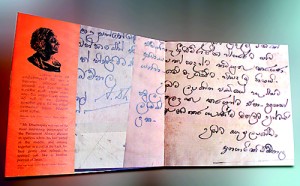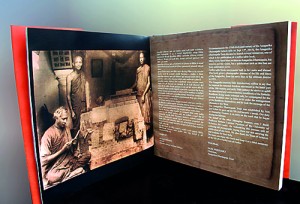Sunday Times 2
Capturing innovation and inspiration
View(s):The name Dharmapala signified ‘one who guards the Dharma’ (doctrine); Anagarika, ‘one who has no fixed abode’.
These lines come from a ten-year-old’s exercise book. Among national heroes her imagination has been caught by the vitality and force of the man who valued the Triple Gem and three others: “My country, my people and my language” and woke the subservient who had accepted foreign domination with his selfless clarion call.
The Anagarika Dharmapala Trust launched a state-of-the art coffee table book simply titled ‘Anagarika Dharmapala’ containing his signature both in Sinhala and English on Monday, September 1 to start the commemoration of the 150th birth anniversary of the charismatic leader of Buddhist resurgence and campaigner for independence in the latter part of the 19th century and the beginning of the 20th century.
The book really is a worthy publication- so full and lively, it absolutely catches the spirit of those times- the need for initiative and inspiration and the surge of response. It gets across such a lot- the first 25 pages are brilliantly economical. I never knew about the Kotahena attack till I watched the TV documentary also launched by the Trust along with this publication.
The book brings out the full gamut- the English text packs a lot in- the international awareness of the Buddhist movement- the contact with the  Asian Buddhists and Western response- then the practical understanding and effort at industrialisation- what a man! Some really bold and enterprising genes in action!
Asian Buddhists and Western response- then the practical understanding and effort at industrialisation- what a man! Some really bold and enterprising genes in action!
The cover is both aesthetically satisfying and conveys so much – not only nationalism but the intention of getting close to the masses.
The photographs have a strong impact in bringing home to the viewer the immense gap between then and now: the poorer pilgrims who return from Dambadiva are struck by what the Anagarika did for them- ” if not for him we could not have worshipped at the places where the Buiddha preached” while others realise the forces he had to confront to achieve his dream.
The parallel texts in Sinhala and English add immensely to the practical value of the book and will prove useful to academic writers by highlighting the different demands of style and presentation in the two languages.
The book will be available from September 17 at the Anagarika Dharmapala Trust office in Colombo 10.
(The reviewer is a former Senior Lecturer and Head of the Department of English, University of Kelaniya
| Book Facts
-Anagarika Dharmapala |

